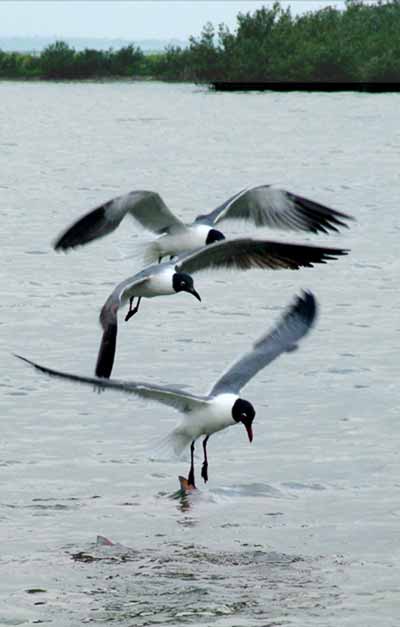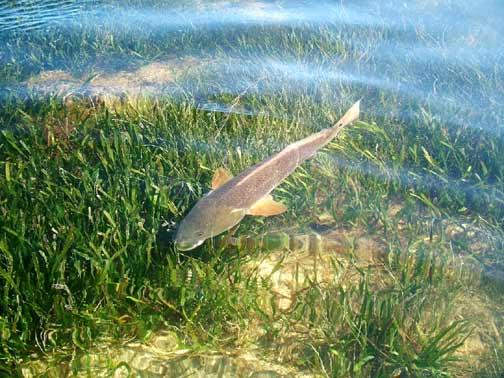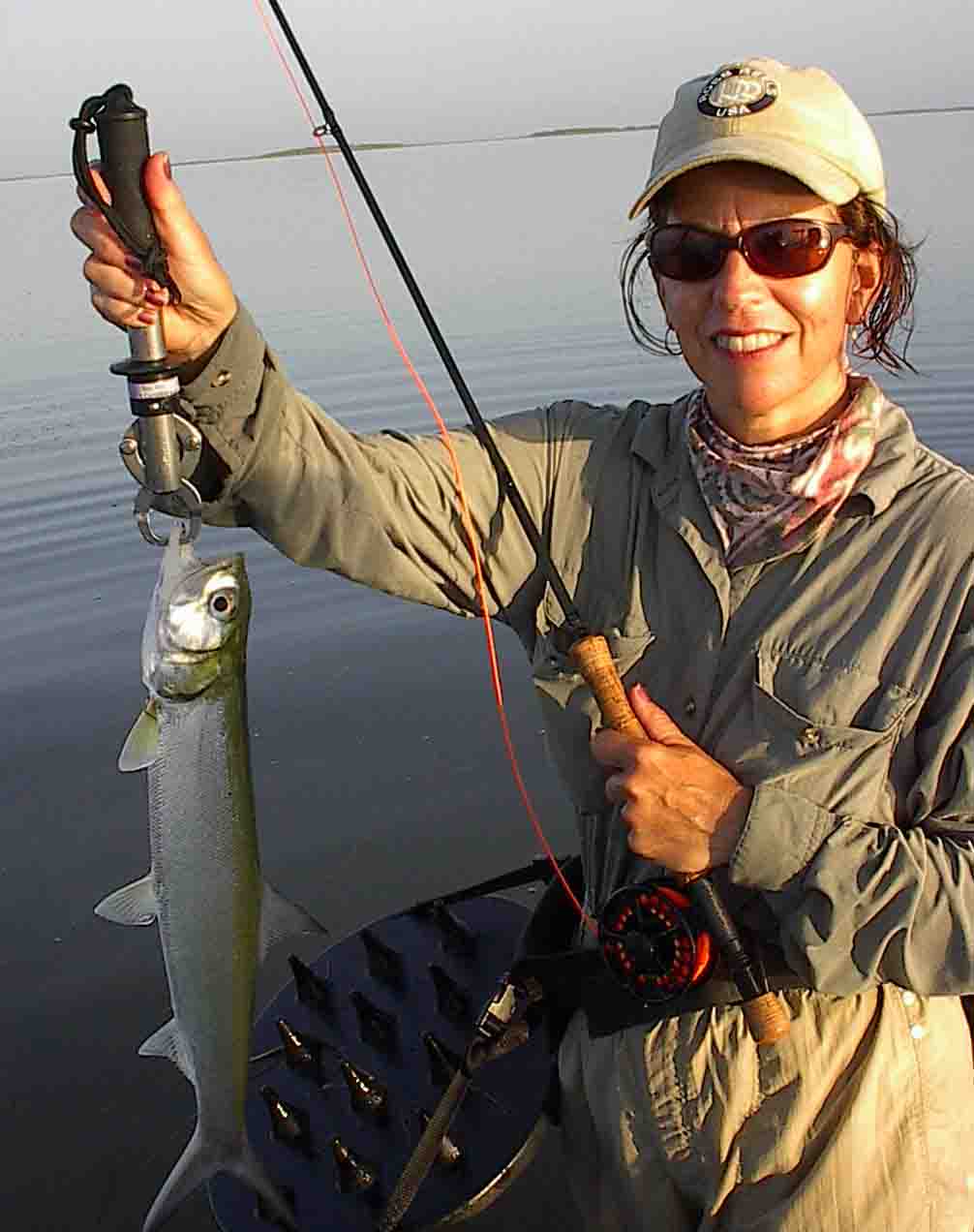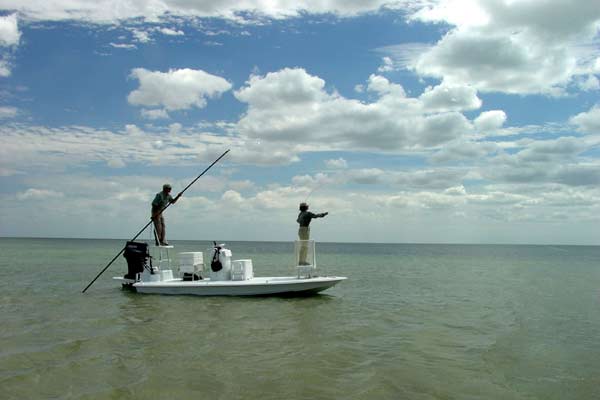Fly
Fish the Texas Tropics:
The Lower Laguna Madre
by
Scott Sparrow
Weary from a week of guiding,
Kathy
and I sipped our coffee on the patio overlooking the Arroyo Colorado.
You would think that going fishing would be the last thing that would
occur to us on a Sunday afternoon in April, but a mild front had passed through that morning,
and the winds were already subsiding. I suggested that it would be a
good time to go fishing, and expected Kathy to look at me like I was
crazy, but I was wrong. Thirty minutes later, we were aboard the Curlew
with our dog Lily, heading east toward the mouth of the Arroyo, and
then north onto the shallow flats of the Lower Laguna Madre.
mild front had passed through that morning,
and the winds were already subsiding. I suggested that it would be a
good time to go fishing, and expected Kathy to look at me like I was
crazy, but I was wrong. Thirty minutes later, we were aboard the Curlew
with our dog Lily, heading east toward the mouth of the Arroyo, and
then north onto the shallow flats of the Lower Laguna Madre.
As we turned into a grassy lagoon along the west
side of the LLM, the sun was low on the horizon, and the water
stretched before us like pewter. At first, there was nothing much to
see but a few jumping mullet, but then as we reached the midsection of
the lagoon, several large schools and countless pods of redfish surged
ahead of the intruding vessel. We shut down in about 15 inches of
water, and -- after promising Lilly that it would soon be her turn --
set off wading toward the most amazing display of tailing redfish that
we’d seen in some time. Fluttering laughing gulls followed the tailing
pods with some difficulty, as the absence of wind made hovering
impossible. Casting VIP poppers to mimic the behavior of fleeing
shrimp, we were soon drawing explosive strikes from redfish competing
for the prize. As I hooked up on a 28-inch red, I looked around and saw
Kathy crouching low to the water, casting her fly into a bouquet of
tails.
The Fishery
Sixty miles long and about five miles wide, the LLM
is the largest continuous shallow water flat in North America.
Sheltered from the open Gulf by Padre Island, the longest barrier
island in the world, the LLM is virtually landlocked, with only two
manmade passes to the Gulf, and a channel connecting it with its sister
bay -- the Upper Laguna Madre -- to the north. Located only just above
the Tropic of Cancer, the LLM is the only true subtropical fishery in
the continental U.S. outside of Florida. Often compared to south
Florida, and even the Carribean, the LLM is known principally for the
clarity of its unpressured shallow waters, and its classic, sight
casting opportunities.
The cast of characters
Redfish. Redfish are the undisputed favorite among
visiting fly fishers. Known for tailing in pods, or as singles -- and cruising with their backs exposed along
shallow banks -- redfish provide highly visual action in a foot or so
of water. Aggressive, hardy, and hard fighting, redfish have all of the
qualities that fly fishers dream of.
and cruising with their backs exposed along
shallow banks -- redfish provide highly visual action in a foot or so
of water. Aggressive, hardy, and hard fighting, redfish have all of the
qualities that fly fishers dream of.
Properly speaking, the LLM is a nursery for juvenile
reds, who remain in the estuary until reaching sexual maturity at the
age of three to six years. In the autumn, the young adults join herds
of “bull” reds near the passes , and spawn for the first time. The
tides bring the eggs back into the estuary where they hatch, but the
adults remain in the open Gulf for the rest of their lives.
Known for their opportunistic, aggressive style, LLM
redfish will take just about any well-presented fly of any
reasonable description. The problem is not the fly, as a rule,
but getting the fish to see or hear the fly. Redfish tend to feed head
down, and so they often fail to perceive the fly unless it’s within a
foot or so from their heads.
Kathy and I like to use VIP poppers over tailing
redfish, because the sound will often draw their attention more
effectively that a subsurface fly. But on a windy day, the
redfish will not readily hear the popper, so a subsurface fly is
usually necessary. Getting your subsurface fly close enough for the
redfish to see it can take considerable stealth and patience. For
instance, I recently guided a man from California, who spotted a
tailing red from the boat, and opted to stalk the fish on foot. It took
him over 20 minutes of stealthy wading, and a couple dozens casts,
before the 26-inch fish saw the fly. But when he finally did, he
took it instantly.
”Speckled” trout. Spotted seatrout provide the
easiest, and the most difficult fly fishing on the LLM. “Schoolie”
trout up to 20 inches long can be easily caught on along the edge of
the Intracoastal Waterway from dawn until midmorning on small poppers
and subsurface flies, alike.
Larger trout, however, behave like an entirely
different species. Breaking away from the schools, they spend much of
their lives in the shallowest waters in solitude. Wary and difficult to
spot on a grassy bottom, big trout are usually seen when it’s too late
-- heading in the other direction. Most anglers that I’ve spoken to
agree that trophy trout have an uncanny ability to sense your approach,
but will acclimate to your presence as along as you don’t make a
commotion.
 While speckled trout range from Maine to the
Yucatan, the LLM holds the largest population of big trout than any
other bay system. Indeed, five out of seven of the current IGFA tippet
class world records were caught on the LLM, including the largest
trout ever taken on a fly rod -- a 15 lb. 6 oz. fish caught by Bud
Rowland of Port Isabel in 2002.
While speckled trout range from Maine to the
Yucatan, the LLM holds the largest population of big trout than any
other bay system. Indeed, five out of seven of the current IGFA tippet
class world records were caught on the LLM, including the largest
trout ever taken on a fly rod -- a 15 lb. 6 oz. fish caught by Bud
Rowland of Port Isabel in 2002.
Other species. Ladyfish provide great sport during
the spring, summer and early fall. Disparaged by the locals, who regard
the lowly “skipjack” as a nuisance, visiting fly fishers are
nonetheless amazed by the blistering runs and almost constant aerial
displays of this sleek cousin of the tarpon.
While ladyfish are common along the Gulf Coast, the
LLM is perhaps the only venue where a fly fisher can regularly sight
cast to world-record ladyfish in a foot of crystal clear water. Four
IGFA tippet-class records were caught sight casting on the LLM during
2003 alone. Visible for up to fifty yards on the “white sand” of the
LLM, ladyfish provide constant action on any given sunny summer day for
anglers who love a great fight.
Sheepshead, black drum and flounder also provide
seasonal alternatives to redfish and trout. Sheepshead can be observed
tailing alongside redfish, and often fool anglers who haven’t learned
to distinguish the gray, concave tails of the sheepshead from the
blue-tinged, darker tails of the redfish. Considered nearly impossible
to catch by many fly fishers, sheepshead will often follow a perfectly
present fly, and will occasionally take it, especially during the fall
and winter.
Black drum in the three-to-six pound range become
plentiful during the late summer and early fall, but are much harder to
entice than their cousin the redfish. Giant drum in the 15-30 lb range
can be found along the edges of channels in the fall. Feeding as they
do principally by smell, they will rarely see a fly, much less take it.
The current state fly rod record of 19 1/2 pounds was caught by a
client in the fall of 2002, by sight casting to the huge fish in a foot of water along a channel’s edge.
foot of water along a channel’s edge.
Flounder are quite willing to take a fly on the LLM;
but since they congregate along channel edges, sight casting fly
fishers rarely encounter them on the flats. But by using sink-tip
lines, and blind casting weighted flies along the edge of the ICW, fly
fishers can often catch a dozen or more flounder.
Tarpon can be found in the surf along Padre Island,
in the Arroyo Colorado, and along the jetties at the Mansfield East Cut
and the Brazos Santiago Pass, but they are rarely seen on the flats of
the LLM. Port Isabel fly shop owner Larry Haines jumped 82 tarpon from
the jetties in 2003, and has landed fish in the 150+ pound range. Fly
fishers who fish from the jetties tend to do best on a fast moving
tide, during the months of April through November; but they find it
exceedingly difficult to land the largest fish among the
barnacle-encrusted granite boulders.
Three species of snook inhabit the Brownsville Ship
Channel, the Arroyo Colorado, and the South Bay of the LLM, but -- like
the tarpon -- do not as a rule venture into the greater lagoon.
Overlooked by most fly fishers intent on sight casting the LLM’s
shallow waters, snook are nonetheless available to anglers willing to
blind cast in deeper waters around structure, or along the
mangrove-lined shores of the South Bay of the LLM.
A Typical Day on the Lower Laguna Madre
Early morning tailing action. If the wind is less
than 10 mph, most fly fishers head for foot-deep water in search of
tailing redfish. During the spring and fall when the tides are high,
tailing redfish can be found in remote westside lagoons where redfish
“pod” up and tail en masse as they flush the shrimp from the seagrass.
Meanwhile, laughing gulls will hover just above the pods in order to
pick off shrimp as they hop across the surface. Using the wind
currents to stay aloft over the fish, the laughing gulls provide
a convenient marker for fly fishers in search of redfish on a windy
morning.
As summer progresses and the tides fall, the sight
casting action shifts to the east side of the ICW. There, over
areas of broken seagrass, tailing fish provide visible targets on a
mirror-like surface until the wind rises by late morning. This is
a die-for scenario, but it’s not easy fishing. While the sheer
noise of feeding fish and squawking birds may drown out the angler’s
approach during the springtime podding action, there is little to mask
the angler’s approach when stalking a single redfish on a calm summer
morning. Indeed, fly fishers eventually learn that waiting for the fish
to come to them can be the key to success in this highly challenging
scenario.
 By midmorning, fly fishers depend on their
polarized sunglasses to sight cast to redfish beneath the surface.
Cruising redfish appear pink against the dark seagrasses, and are
fairly easy to spot on a cloudless day. Although fly fishers often
worry about windy conditions, a moderate wind actually helps by
breaking the surface tension of the water, permitting the angler to see
the fish through the wave face.
By midmorning, fly fishers depend on their
polarized sunglasses to sight cast to redfish beneath the surface.
Cruising redfish appear pink against the dark seagrasses, and are
fairly easy to spot on a cloudless day. Although fly fishers often
worry about windy conditions, a moderate wind actually helps by
breaking the surface tension of the water, permitting the angler to see
the fish through the wave face.
The Big Trout Option. Early morning tailing reds are
hard to pass up, but for those anglers who are entranced by big trout,
the spoil islands and grassy flats adjacent to the Intracoastal
Waterway provide sight casting to trophy trout for the first two
or three hours of the day. It is not uncommon to observe trophy trout
milling about in less than a foot of grassy water with their backs and
tails exposed. Big trout are considered more difficult than permit to
catch, but fly fishers who have dedicated themselves to the pursuit of
this elusive predator insist that big trout are not so much finicky as
intolerant of imperfect presentations.
The Lure of the White Sand. Regardless of the
season, a cloudless sky will lure most fly fishers to the sparsely
vegetated eastern edge of the LLM by late morning. Known locally as
“the white sand,” this flat resembles a Caribbean bonefish flat, and
varies in depth from less than a foot to about 18 inches. There, on a
sunny day, fly fishers who wade downwind can spot fish moving upwind
against the wind-driven current. Feeding on small worms and crabs that
live in the sand, redfish will travel head down, making it somewhat
easier to approach them in the crystal clear water. Solitary or small
groups of trout also cruise this area, and -- like redfish -- can often
be seen traveling with packs of ladyfish.
Redfish, trout and ladyfish tend to follow sting
rays on the white sand, and a single sting ray may host as many as a
dozen fish. Typically, the trailing fish are “cocked and ready” for
whatever the ray might flush from the bottom. Consequently, dropping a
fly in the ray’s vicinity will often provoke an immediate strike.
As the sunlight fails, fly fishers may go full
circle and return to the west side of the LLM in search of redfish
resuming their podding action in the late afternoon. Even
when the southeast wind has turned the water choppy and turbid, the
redfish will often tail until nightfall, calling the laughing gulls
once again to flight.
I’ve heard many people say that there’s something
magical about the Lower Laguna Madre. Perhaps it’s the vast,
unpressured flats that give anglers a sense of adventure that often
seems lacking in today’s world. Or maybe it’s the soothing clarity of
the shallow water, and the lush seagrass meadows that go on for as far
as the eye can see. But you don’t have to believe in magic to be
impressed with a fishery that provides classic sight casting
opportunities to big fish in shallow, clear water within a day of
travel for any fly fisher living in the continental U.S.
.
 mild front had passed through that morning,
and the winds were already subsiding. I suggested that it would be a
good time to go fishing, and expected Kathy to look at me like I was
crazy, but I was wrong. Thirty minutes later, we were aboard the Curlew
with our dog Lily, heading east toward the mouth of the Arroyo, and
then north onto the shallow flats of the Lower Laguna Madre.
mild front had passed through that morning,
and the winds were already subsiding. I suggested that it would be a
good time to go fishing, and expected Kathy to look at me like I was
crazy, but I was wrong. Thirty minutes later, we were aboard the Curlew
with our dog Lily, heading east toward the mouth of the Arroyo, and
then north onto the shallow flats of the Lower Laguna Madre.  and cruising with their backs exposed along
shallow banks -- redfish provide highly visual action in a foot or so
of water. Aggressive, hardy, and hard fighting, redfish have all of the
qualities that fly fishers dream of.
and cruising with their backs exposed along
shallow banks -- redfish provide highly visual action in a foot or so
of water. Aggressive, hardy, and hard fighting, redfish have all of the
qualities that fly fishers dream of. While speckled trout range from Maine to the
Yucatan, the LLM holds the largest population of big trout than any
other bay system. Indeed, five out of seven of the current IGFA tippet
class world records were caught on the LLM, including the largest
trout ever taken on a fly rod -- a 15 lb. 6 oz. fish caught by Bud
Rowland of Port Isabel in 2002.
While speckled trout range from Maine to the
Yucatan, the LLM holds the largest population of big trout than any
other bay system. Indeed, five out of seven of the current IGFA tippet
class world records were caught on the LLM, including the largest
trout ever taken on a fly rod -- a 15 lb. 6 oz. fish caught by Bud
Rowland of Port Isabel in 2002.  foot of water along a channel’s edge.
foot of water along a channel’s edge. By midmorning, fly fishers depend on their
polarized sunglasses to sight cast to redfish beneath the surface.
Cruising redfish appear pink against the dark seagrasses, and are
fairly easy to spot on a cloudless day. Although fly fishers often
worry about windy conditions, a moderate wind actually helps by
breaking the surface tension of the water, permitting the angler to see
the fish through the wave face.
By midmorning, fly fishers depend on their
polarized sunglasses to sight cast to redfish beneath the surface.
Cruising redfish appear pink against the dark seagrasses, and are
fairly easy to spot on a cloudless day. Although fly fishers often
worry about windy conditions, a moderate wind actually helps by
breaking the surface tension of the water, permitting the angler to see
the fish through the wave face.